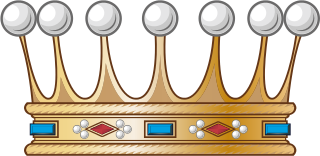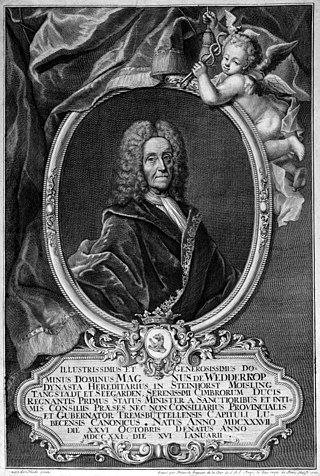
The Swedish nobility has historically been a legally and/or socially privileged class in Sweden, and part of the so-called frälse. The archaic term for nobility, frälse, also included the clergy, a classification defined by tax exemptions and representation in the diet. Today the nobility does not maintain its former legal privileges although family names, titles and coats of arms are still protected. The Swedish nobility consists of both "introduced" and "unintroduced" nobility, where the latter has not been formally "introduced" at the House of Nobility (Riddarhuset). The House of Nobility still maintains a fee for male members over the age of 18 for upkeep on pertinent buildings in Stockholm.

Freiherr, Freifrau and Freiin are designations used as titles of nobility in the German-speaking areas of the Holy Roman Empire and in its various successor states, including Austria, Prussia, Bavaria, Liechtenstein, Luxembourg, etc. Traditionally, it denotes the titled rank within the nobility above Ritter (knight) and Edler and below Graf. The title superseded the earlier medieval form, Edelherr.
The aristocracy of Norway is the modern and medieval aristocracy in Norway. Additionally, there have been economical, political, and military elites that—relating to the main lines of Norway's history—are generally accepted as nominal predecessors of the aforementioned. Since the 16th century, modern aristocracy is known as nobility.
The German nobility and royalty were status groups of the medieval society in Central Europe, which enjoyed certain privileges relative to other people under the laws and customs in the German-speaking area, until the beginning of the 20th century. Historically, German entities that recognized or conferred nobility included the Holy Roman Empire (962–1806), the German Confederation (1814–1866) and the German Empire (1871–1918). Chancellor Otto von Bismarck in the German Empire had a policy of expanding his political base by ennobling nouveau riche industrialists and businessmen who had no noble ancestors. The nobility flourished during the dramatic industrialization and urbanization of Germany after 1850. Landowners modernized their estates, and oriented their business to an international market. Many younger sons were positioned in the rapidly growing national and regional civil service bureaucracies, as well as in the officer corps of the military. They acquired not only the technical skills but the necessary education in high prestige German universities that facilitated their success. Many became political leaders of new reform organizations such as agrarian leagues, and pressure groups. The Roman Catholic nobility played a major role in forming the new Centre Party in resistance to Bismarck's anti-Catholic Kulturkampf, while Protestant nobles were similarly active in the Conservative Party.

The House of Nobility either refers to the institution of the Finnish nobility or the palace of the noble estate. The Finnish nobility was from 1809 until 1906 the first of the four estates of the realm.

The Finnish nobility was historically a privileged class in Finland, deriving from its period as part of Sweden and the Russian Empire. Noble families and their descendants are still a part of Finnish republican society, but except for the titles themselves, no longer retain any specific or granted privileges. A majority of Finnish nobles have traditionally been Swedish-speakers using their titles mostly in Swedish. The Finnish nobility today has some 6,000 male and female members.

The Baltic German nobility was a privileged social class in the territories of modern-day Estonia and Latvia. It existed continuously from the Northern Crusades and the medieval foundation of Terra Mariana.

The von Rohr is an old German noble family, also belonging to the Swedish and Finnish nobility.

The Staël von Holstein family is a Baltic-German Baronial family originating from Westphalia.

Magnus Freiherr von Wedderkop (1637–1721), was a German nobleman and a royal German lieutenant.

Klinkowström or Klinckowström is a noble house of German origin with Prussian-Austrian and Swedish branches.

The Uexküll family is the name of an old and distinguished Baltic-German noble family, which derived its name from the town of Uexküll, today Ikšķile in Latvia.
A nobiliary particle is a type of onomastic particle used in a surname or family name in many Western cultures to signal the nobility of a family. The particle used varies depending on the country, language and period of time. In some languages, it is the same as a regular prepositional particle that was used in the creation of many surnames. In some countries, it became customary to distinguish the nobiliary particle from the regular one by a different spelling, although in other countries these conventions did not arise, occasionally resulting in ambiguity. The nobiliary particle can often be omitted in everyday speech or certain contexts.

The Livonian Knighthood was a fiefdom that existed in Livonia. It was formed in 1561 by Baltic German nobles and disbanded in 1917 in Estonia, and in 1920 in Latvia. Like other Baltic knighthoods, the Livonian also had semi-autonomous privileged status in the Russian Empire.

Magnus Alexander Ludwig von Güldenstubbe was a Baltic German general of the Imperial Russian Army and commanded the Moscow Military District from 1864 to 1879. He participated in November Uprising in Poland and the Crimean War.

The Koskullfamily, also written as Koschkull, is a wealthy aristocratic family of Livonian and German origin, famous for their extensive lands and manors. The family is descended from the first King of Livonia and officially established in Livonia as Koskele in 1302. The family spread to Estonia, Courland and Poland in the 15th century, Sweden and Finland in the 17th century, and Prussia and Russia in the 18th century. Several branches of the family still exist today. The Koskulls are believed to be related to the von der Pahlen family.

Peter Paul Alexander von Baranoff was a Baltic German military officer and statesman. During the First World War, Baranoff was known for his investigations, most notably his investigation of fellow general Paul von Rennenkampf's actions during the Battle of Łódź.

The Rennenkampff family is a Baltic-German noble family. It is of Westphalian origin and originated in Osnabrück. They hold the title of Edler.

The Kotzebue family is a Baltic German noble family of Brandenburgish descent, tracing its origin back to Kossebau in Altmark. They held nobility status in the Russian Empire and the Kingdom of Bavaria. The English name of the Alaskan Inuit city of Kotzebue, as well as the neighboring Kotzebue Sound, in the Alaskan Arctic take their names from Otto von Kotzebue, a Russian naval officer of this family.

The Toll family was a Baltic German noble family of possible Hollandish origin. According to legend, the family's name originated from a castle near Leiden. The family held Swedish and Russian baronial and comital titles, Austrian baronial titles, Prussian, Oldenburgish, Finnish untitled noble status and also possibly belonged to Dutch nobility.

















